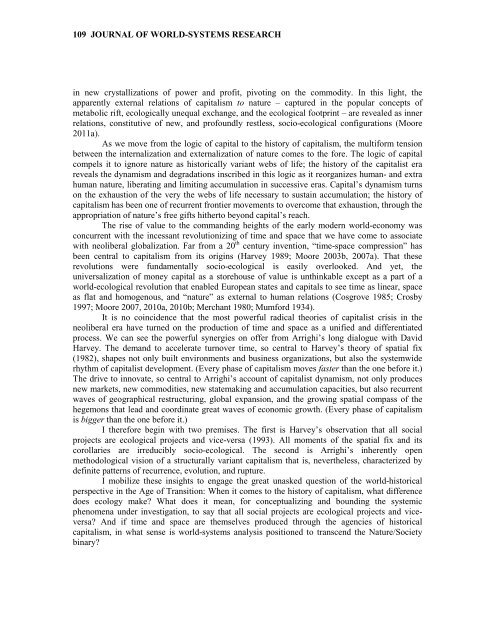Entire Volume 17 issue 1 - Journal of World-Systems Research ...
Entire Volume 17 issue 1 - Journal of World-Systems Research ...
Entire Volume 17 issue 1 - Journal of World-Systems Research ...
You also want an ePaper? Increase the reach of your titles
YUMPU automatically turns print PDFs into web optimized ePapers that Google loves.
109 JOURNAL OF WORLD-SYSTEMS RESEARCH<br />
in new crystallizations <strong>of</strong> power and pr<strong>of</strong>it, pivoting on the commodity. In this light, the<br />
apparently external relations <strong>of</strong> capitalism to nature – captured in the popular concepts <strong>of</strong><br />
metabolic rift, ecologically unequal exchange, and the ecological footprint – are revealed as inner<br />
relations, constitutive <strong>of</strong> new, and pr<strong>of</strong>oundly restless, socio-ecological configurations (Moore<br />
2011a).<br />
As we move from the logic <strong>of</strong> capital to the history <strong>of</strong> capitalism, the multiform tension<br />
between the internalization and externalization <strong>of</strong> nature comes to the fore. The logic <strong>of</strong> capital<br />
compels it to ignore nature as historically variant webs <strong>of</strong> life; the history <strong>of</strong> the capitalist era<br />
reveals the dynamism and degradations inscribed in this logic as it reorganizes human- and extra<br />
human nature, liberating and limiting accumulation in successive eras. Capital’s dynamism turns<br />
on the exhaustion <strong>of</strong> the very the webs <strong>of</strong> life necessary to sustain accumulation; the history <strong>of</strong><br />
capitalism has been one <strong>of</strong> recurrent frontier movements to overcome that exhaustion, through the<br />
appropriation <strong>of</strong> nature’s free gifts hitherto beyond capital’s reach.<br />
The rise <strong>of</strong> value to the commanding heights <strong>of</strong> the early modern world-economy was<br />
concurrent with the incessant revolutionizing <strong>of</strong> time and space that we have come to associate<br />
with neoliberal globalization. Far from a 20 th century invention, “time-space compression” has<br />
been central to capitalism from its origins (Harvey 1989; Moore 2003b, 2007a). That these<br />
revolutions were fundamentally socio-ecological is easily overlooked. And yet, the<br />
universalization <strong>of</strong> money capital as a storehouse <strong>of</strong> value is unthinkable except as a part <strong>of</strong> a<br />
world-ecological revolution that enabled European states and capitals to see time as linear, space<br />
as flat and homogenous, and “nature” as external to human relations (Cosgrove 1985; Crosby<br />
1997; Moore 2007, 2010a, 2010b; Merchant 1980; Mumford 1934).<br />
It is no coincidence that the most powerful radical theories <strong>of</strong> capitalist crisis in the<br />
neoliberal era have turned on the production <strong>of</strong> time and space as a unified and differentiated<br />
process. We can see the powerful synergies on <strong>of</strong>fer from Arrighi’s long dialogue with David<br />
Harvey. The demand to accelerate turnover time, so central to Harvey’s theory <strong>of</strong> spatial fix<br />
(1982), shapes not only built environments and business organizations, but also the systemwide<br />
rhythm <strong>of</strong> capitalist development. (Every phase <strong>of</strong> capitalism moves faster than the one before it.)<br />
The drive to innovate, so central to Arrighi’s account <strong>of</strong> capitalist dynamism, not only produces<br />
new markets, new commodities, new statemaking and accumulation capacities, but also recurrent<br />
waves <strong>of</strong> geographical restructuring, global expansion, and the growing spatial compass <strong>of</strong> the<br />
hegemons that lead and coordinate great waves <strong>of</strong> economic growth. (Every phase <strong>of</strong> capitalism<br />
is bigger than the one before it.)<br />
I therefore begin with two premises. The first is Harvey’s observation that all social<br />
projects are ecological projects and vice-versa (1993). All moments <strong>of</strong> the spatial fix and its<br />
corollaries are irreducibly socio-ecological. The second is Arrighi’s inherently open<br />
methodological vision <strong>of</strong> a structurally variant capitalism that is, nevertheless, characterized by<br />
definite patterns <strong>of</strong> recurrence, evolution, and rupture.<br />
I mobilize these insights to engage the great unasked question <strong>of</strong> the world-historical<br />
perspective in the Age <strong>of</strong> Transition: When it comes to the history <strong>of</strong> capitalism, what difference<br />
does ecology make? What does it mean, for conceptualizing and bounding the systemic<br />
phenomena under investigation, to say that all social projects are ecological projects and viceversa?<br />
And if time and space are themselves produced through the agencies <strong>of</strong> historical<br />
capitalism, in what sense is world-systems analysis positioned to transcend the Nature/Society<br />
binary?





